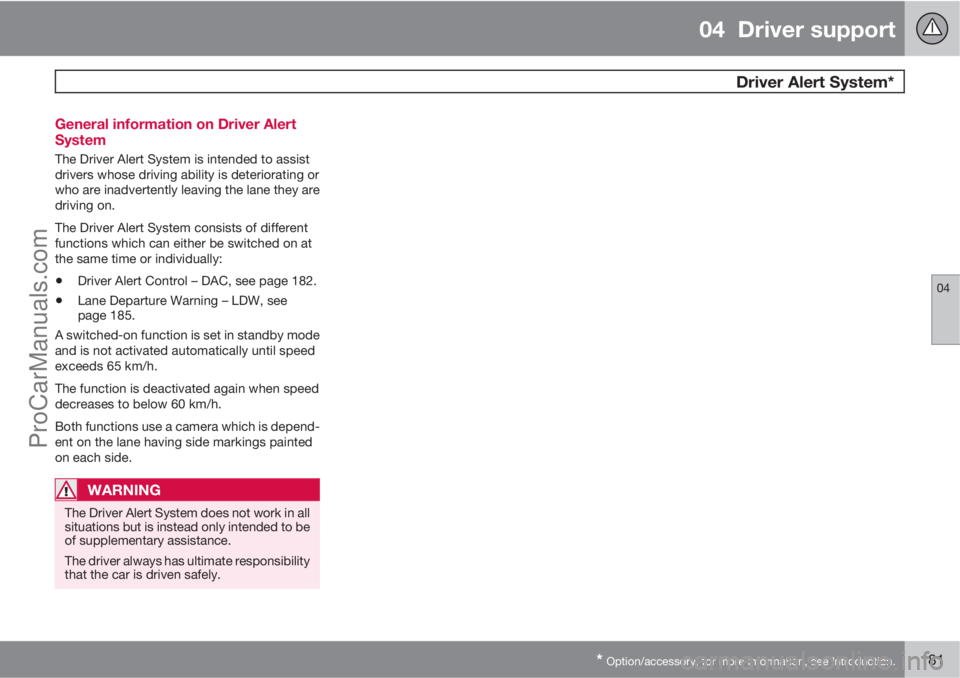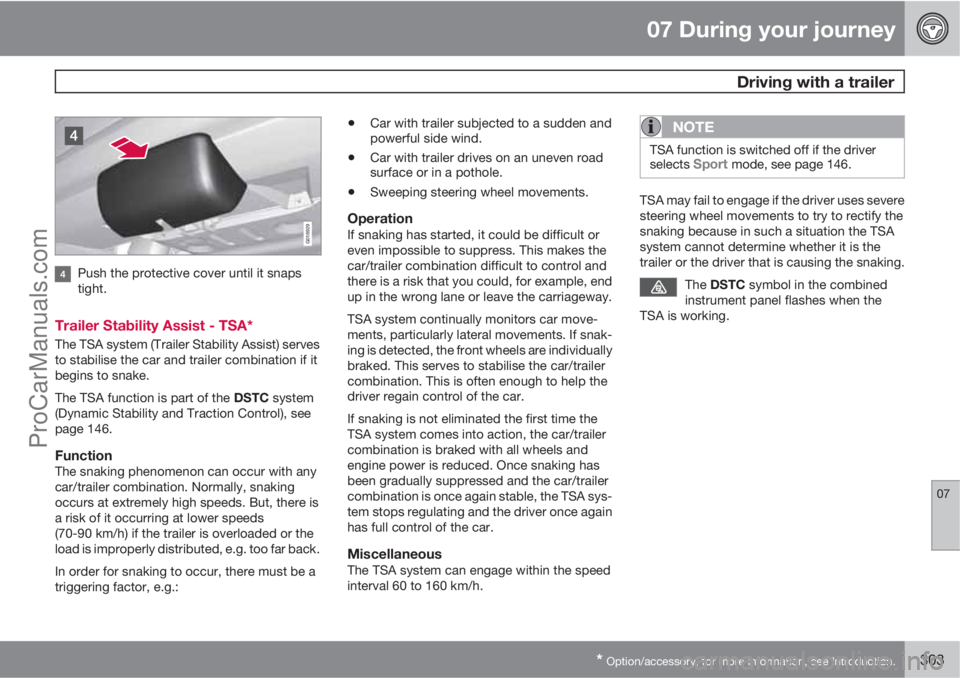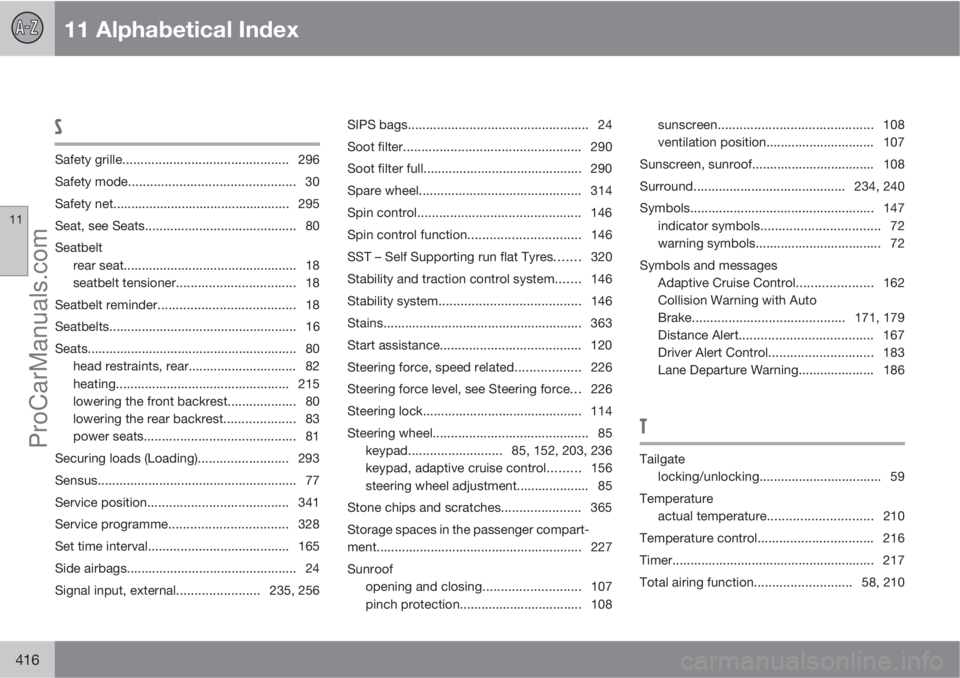2013 VOLVO V60 lane assist
[x] Cancel search: lane assistPage 157 of 422

04 Driver support
Adaptive cruise control*
04
* Option/accessory, for more information, see Introduction.155
WARNING
Adaptive cruise control is not a collision
avoidance system. The driver must inter-
vene if the system does not detect a vehicle
in front.
The adaptive cruise control does not brake
for humans or animals, and not for small
vehicles such as bicycles and motorcycles.
Nor for oncoming, slow or stationary vehi-
cles and objects.
Do not use the adaptive cruise control, for
example, in city traffic, in dense traffic, at
junctions, on slippery surfaces, with a lot of
water or slush on the road, in heavy rain/
snow, in poor visibility, on winding roads or
on slip roads.
The distance to the vehicle ahead is mainly
measured by a radar sensor. Cruise control
regulates the speed with acceleration and
braking. It is normal for the brakes to emit a low
sound when they are being used by the Adap-
tive cruise control.
WARNING
The brake pedal moves when the cruise
control brakes. Do not rest your foot under
the brake pedal as it could become trapped.
The adaptive cruise control aims to follow the
vehicle ahead in the same lane at a time interval
set by the driver. If the radar sensor cannot see
any vehicle in front then the car will instead
maintain the cruise control's set speed. This
also happens if the speed of the vehicle in front
exceeds the cruise control's set speed.
The adaptive cruise control aims to control the
speed in a smooth way. In situations that
demand sudden braking the driver must brake
himself/herself. This applies with large differ-
ences in speed, or if the vehicle in front brakes
heavily. Due to limitations in the radar sensor,
braking may come unexpectedly or not at all,
see page 160.
The adaptive cruise control can be activated to
follow another vehicle at speeds from
30 km/h
2 up to 200 km/h. If the speed falls
below 30 km/h or if the engine speed becomes
too low, the cruise control is set in standby
mode at which automatic braking ceases - the
driver must then take over himself/herself to
maintain a safe distance to the vehicle ahead.
Warning lamp - braking by driver
required
Adaptive cruise control has a braking capacity
that is equivalent to more than 40% of the car's
braking capacity.If the car needs to be braked more heavily than
cruise control capacity and the driver does not
brake, then the cruise control uses the collision
warning system's warning lamp and warning
sound (see page 173) to alert the driver that
immediate intervention is required.
NOTE
The warning lamp may be difficult to notice
in strong sunlight or when sunglasses are
being worn.
WARNING
Cruise control only warns of vehicles
detected by the radar sensor. Consequently
there may be no warning or it may be sub-
ject to a delay. Do not wait for a warning but
brake when it is necessary.
Steep roads and/or heavy loadBear in mind that the adaptive cruise control is
primarily intended for use when driving on level
road surfaces. It may have difficultly in keeping
the correct distance from the vehicle ahead
when driving on steep roads, with a heavy load
or with a trailer - in which case, be extra atten-
tive and ready to slow down.
2Queue Assistant (in cars with automatic gearbox) can operate in the range of 0-200 km/h, see page 159.
ProCarManuals.com
Page 160 of 422

04 Driver support
Adaptive cruise control*
04
158* Option/accessory, for more information, see Introduction.
Keypad without Speed limiter*To temporarily disengage Cruise control and
set it in standby mode:
•Press the steering wheel button .
Standby mode due to driver interventionCruise control is temporarily disengaged and
set in standby mode if:
•the foot brake is used
•the clutch pedal is depressed for longer
than 1 minute6
•the gear selector is moved to N position
(automatic gearbox)
•the driver maintains a speed higher than
the set speed for longer than 1 minute.
The driver must then regulate the speed.
A temporary increase in speed with the accel-
erator pedal, e.g. during overtaking, does not
affect the cruise control setting - the car returns
to the last stored speed when the accelerator
pedal is released.
Automatic standby modeThe Adaptive cruise control is dependent on
other systems, e.g.. DSTC (see page 146). Ifany of these systems stop working then cruise
control is automatically deactivated.
In the event of automatic deactivation a signal
will sound and the message
Cruise control
Cancelled is shown in the display. The driver
must then intervene and adapt the speed and
distance to the vehicle ahead.
An automatic deactivation can be due to:
•engine speed is too low/high
•speed falls below 30 km/h7
•wheels lose traction
•brake temperature is high
•the radar sensor is covered e.g. by wet
snow or heavy rain (radar waves blocked).
Resume set speedCruise control in standby mode is re-activated
with one press on the steering wheel button
- the speed is then set to the last stored
speed.
NOTE
A significant increase in speed may arise
after the speed has been resumed with .
Overtaking another vehicleWhen the car is following another vehicle and
the driver indicates an imminent overtake with
the direction indicator
8, the Cruise control
helps to briefly accelerate the car towards the
vehicle in front.
The function is active at speeds
above 70 km/h.
WARNING
Be aware that this function can be activated
in more situations other than during over-
taking, e.g. when a direction indicator is
used to indicate a change of lane or exit to
another road - the car will then accelerate
briefly.
Deactivate
Keypad with Speed limiter
Adaptive cruise control is deactivated with the
steering wheel button
. The set speed is
cleared and cannot be resumed with the
button.
Keypad without Speed limiterWith a short press on the steering wheel button
the cruise control is set in standby mode.
6Disengaging and selecting a higher or lower gear does not involve standby mode.7Does not apply to a car with Queue Assistant - it manages right down to stationary.8On left flash only in left-hand drive car, or right flash in right-hand drive car.
ProCarManuals.com
Page 162 of 422

04 Driver support
Adaptive cruise control*
04
160* Option/accessory, for more information, see Introduction.
WARNING
When the cruise control is following another
vehicle at speeds in excess of 30 km/h and
the target is changed from a moving vehicle
to a stationary vehicle, the cruise control will
ignore the stationary vehicle and instead
select the stored speed.
•The driver must intervene him/herself
and brake.
Automatic standby mode with change of
target
Cruise control is disengaged and set in
standby mode:
•when the speed is below 5 km/h and cruise
control is not sure whether the target
object is a stationary vehicle or some other
object, e.g. a speed bump.
•when the speed is below 5 km/h and the
vehicle in front turns off so the cruise con-
trol no longer has a vehicle to follow.
Termination of automatic braking at a
standstill
In certain situations Queue Assist automati-
cally interrupts braking when stationary. This
means that the brakes are released and the car
may start to roll - the driver must therefore
intervene and brake the car himself/herself in
order to maintain its position.Queue Assist releases the foot brake and sets
cruise control in standby mode in the following
situations:
•the driver puts his/her foot on the brake
pedal
•the parking brake is applied
•the gear selector is moved to P, N or R
position
•the driver sets the cruise control in standby
mode.
Automatic activation parking brakeIn some situations Queue Assist applies the
parking brake in order to keep the car station-
ary.
This takes place if:
•the driver opens the door or takes off his/
her seatbelt
•DSTC is changed from Normal to Sport
mode
•Queue Assist has held the car stationary
for more than 4 minutes
•the engine is switched off
•the brakes have overheated.
The radar sensor and its limitations
The radar sensor is used - apart from by Adap-
tive cruise control - by the following functions
as well:
•Collision Warning with Auto Brake, see
page 173
•Distance Warning, see page 165.
The function of the radar sensor is to detect
cars or larger vehicles in the same direction, in
the same lane.
Modification of the radar sensor could result in
it being illegal to use.
ProCarManuals.com
Page 183 of 422

04 Driver support
Driver Alert System*
04
* Option/accessory, for more information, see Introduction.181 General information on Driver Alert
System
The Driver Alert System is intended to assist
drivers whose driving ability is deteriorating or
who are inadvertently leaving the lane they are
driving on.
The Driver Alert System consists of different
functions which can either be switched on at
the same time or individually:
•Driver Alert Control – DAC, see page 182.
•Lane Departure Warning – LDW, see
page 185.
A switched-on function is set in standby mode
and is not activated automatically until speed
exceeds 65 km/h.
The function is deactivated again when speed
decreases to below 60 km/h.
Both functions use a camera which is depend-
ent on the lane having side markings painted
on each side.
WARNING
The Driver Alert System does not work in all
situations but is instead only intended to be
of supplementary assistance.
The driver always has ultimate responsibility
that the car is driven safely.
ProCarManuals.com
Page 195 of 422

04 Driver support
Park assist camera*
04
* Option/accessory, for more information, see Introduction.193
Cars with reversing sensors*
Coloured areas (x 4, one per sensor) show dis-
tance.
If the car is also equipped with parking assis-
tance sensors (see page 188) the distance indi-
cation will be more precise and the coloured
areas show which of the 4 sensors is/are reg-
istering an obstacle.
The colour of the areas changes with decreas-
ing distance to the obstacle - from yellow to
orange to red.
Colour / paintDistance
(metres)
Yellow1.5–
Orange0.3–1.5
Red0–0.3
SettingsPress OK/MENU when a camera view is
shown. Make the settings as desired.
Miscellaneous
•The default setting is that the camera is
activated when reverse gear is engaged.
•One press on CAM activates the camera
even if reverse gear is not engaged.
•Change between normal and zoomed
image by turning TUNE or by pressing
CAM.
•If the car has more cameras* installed then
the camera in use is changed by turning
TUNE.
Limitations
NOTE
A bike carrier or other accessory mounted
on the rear of the car could obscure the
camera's view.
Pay attention to the possibility that, even if it
only looks like a relatively small part of the
image is obscured, it could be a relatively large
sector that is hidden from view. Obstacles
could thereby go undetected until they are very
close to the car.
To bear in mind
•Keep the camera lens free from dirt, ice
and snow.
•Clean the camera lens regularly with luke-
warm water and car shampoo - take care
not to scratch the lens.
ProCarManuals.com
Page 305 of 422

07 During your journey
Driving with a trailer
07
* Option/accessory, for more information, see Introduction.303
G018929
Push the protective cover until it snaps
tight.
Trailer Stability Assist - TSA*
The TSA system (Trailer Stability Assist) serves
to stabilise the car and trailer combination if it
begins to snake.
The TSA function is part of the DSTC system
(Dynamic Stability and Traction Control), see
page 146.
FunctionThe snaking phenomenon can occur with any
car/trailer combination. Normally, snaking
occurs at extremely high speeds. But, there is
a risk of it occurring at lower speeds
(70-90 km/h) if the trailer is overloaded or the
load is improperly distributed, e.g. too far back.
In order for snaking to occur, there must be a
triggering factor, e.g.:
•Car with trailer subjected to a sudden and
powerful side wind.
•Car with trailer drives on an uneven road
surface or in a pothole.
•Sweeping steering wheel movements.
OperationIf snaking has started, it could be difficult or
even impossible to suppress. This makes the
car/trailer combination difficult to control and
there is a risk that you could, for example, end
up in the wrong lane or leave the carriageway.
TSA system continually monitors car move-
ments, particularly lateral movements. If snak-
ing is detected, the front wheels are individually
braked. This serves to stabilise the car/trailer
combination. This is often enough to help the
driver regain control of the car.
If snaking is not eliminated the first time the
TSA system comes into action, the car/trailer
combination is braked with all wheels and
engine power is reduced. Once snaking has
been gradually suppressed and the car/trailer
combination is once again stable, the TSA sys-
tem stops regulating and the driver once again
has full control of the car.
MiscellaneousThe TSA system can engage within the speed
interval 60 to 160 km/h.
NOTE
TSA function is switched off if the driver
selects Sport mode, see page 146.
TSA may fail to engage if the driver uses severe
steering wheel movements to try to rectify the
snaking because in such a situation the TSA
system cannot determine whether it is the
trailer or the driver that is causing the snaking.
The DSTC symbol in the combined
instrument panel flashes when the
TSA is working.
ProCarManuals.com
Page 416 of 422

11 Alphabetical Index
11
414
Manual gearbox....................................... 121
GSI - Gear selector assistance........... 121
towing and recovery........................... 304
Manual gear positions (Geartronic).......... 123
Max. roof load ......................................... 373
Media, Bluetooth
�Ÿ ................................... 259
media player ........................................... 252
Memory function in seats.......................... 81
Menu navigation, Infotainment ............... 238
Menus/functions...................................... 204
Menus and messages.............................. 200
Menu system MY CAR............................202
Messages and symbols
Adaptive Cruise Control..................... 162
Collision Warning with Auto
Brake..........................................171, 179
Distance Alert..................................... 167
Driver Alert Control............................. 183
Lane Departure Warning..................... 186
Messages in BLIS.................................... 196
Messages in the combined instrument
panel........................................................200
Messages in the information display....... 147Meters
fuel gauge............................................. 72
speedometer......................................... 72
tachometer........................................... 72
Microphone.............................................. 262
Misting..................................................... 217
attending to the windows...................210
condensation in headlamps............... 361
remove with the air vents................... 219
timer function...................................... 217
Mobile phone
connect............................................... 263
handsfree............................................ 262
register phone..................................... 263
voice control....................................... 271
Mood lighting............................................. 93
MY CAR................................................... 202
O
Oil, see also Engine oil............................. 378
Oil level low.............................................. 329
Overheating............................................. 298
Owner's manual, environmental labelling. . 12
P
PACOS....................................................... 22
PACOS, switch.......................................... 22
Paintwork
colour code......................................... 365
damage and touch-up........................ 365
Panel lighting............................................. 86
Panic function............................................ 46
Park assist camera.................................. 191
Parking assistance................................... 188
parking assistance sensors................ 190
Parking brake........................................... 137
Parking heater.......................................... 220
battery and fuel................................... 220
parking on a hill..................................220
time setting......................................... 222
Passenger compartment.........................227
Passenger compartment filter................. 210
Passenger compartment heater
fuel-driven........................................... 220
PCC – Personal Car Communicator
functions............................................... 45
range............................................... 46, 47
Pedestrian protection..............................173
ProCarManuals.com
Page 418 of 422

11 Alphabetical Index
11
416
S
Safety grille.............................................. 296
Safety mode.............................................. 30
Safety net................................................. 295
Seat, see Seats.......................................... 80
Seatbelt
rear seat................................................ 18
seatbelt tensioner................................. 18
Seatbelt reminder...................................... 18
Seatbelts.................................................... 16
Seats.......................................................... 80
head restraints, rear.............................. 82
heating................................................ 215
lowering the front backrest................... 80
lowering the rear backrest.................... 83
power seats.......................................... 81
Securing loads (Loading)......................... 293
Sensus....................................................... 77
Service position....................................... 341
Service programme................................. 328
Set time interval....................................... 165
Side airbags............................................... 24
Signal input, external.......................235, 256SIPS bags.................................................. 24
Soot filter................................................. 290
Soot filter full............................................ 290
Spare wheel............................................. 314
Spin control............................................. 146
Spin control function...............................146
SST – Self Supporting run flat Tyres....... 320
Stability and traction control system....... 146
Stability system....................................... 146
Stains....................................................... 363
Start assistance....................................... 120
Steering force, speed related.................. 226
Steering force level, see Steering force... 226
Steering lock............................................ 114
Steering wheel........................................... 85
keypad.......................... 85, 152, 203, 236
keypad, adaptive cruise control......... 156
steering wheel adjustment.................... 85
Stone chips and scratches...................... 365
Storage spaces in the passenger compart-
ment......................................................... 227
Sunroof
opening and closing...........................107
pinch protection.................................. 108sunscreen........................................... 108
ventilation position.............................. 107
Sunscreen, sunroof.................................. 108
Surround.......................................... 234, 240
Symbols................................................... 147
indicator symbols................................. 72
warning symbols................................... 72
Symbols and messages
Adaptive Cruise Control..................... 162
Collision Warning with Auto
Brake..........................................171, 179
Distance Alert..................................... 167
Driver Alert Control............................. 183
Lane Departure Warning..................... 186
T
Tailgate
locking/unlocking.................................. 59
Temperature
actual temperature.............................210
Temperature control................................ 216
Timer........................................................ 217
Total airing function...........................58, 210
ProCarManuals.com